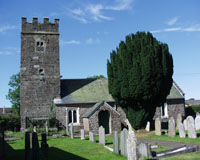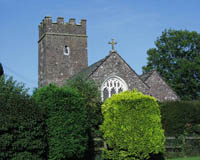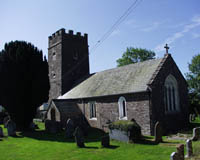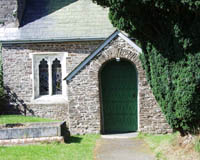 |
 |
 |
 |
 |
 |
 |
 |
 |
 |
 |
 |
 |
 |
 |
 |
 |
 |
|
St. Thomas A'Becket PUDDINGTON - spelled 'Potington' in the Domesday Book of 1086 - may derive from 'Putta's Tun' - the farm of a Saxon Chief. The dedication to the murdered Archbishop of Canterbury (despite Henry VIII's orders to suppress such dedications) may arise from having had a King (Edward I) as its first patron. Until 1837 the church had a single nave, but Rector David Llewellyn who arrived in 1835 and stayed for 36 years transformed the whole church, except the porch and tower. (The window by the pulpit commemorates him, and that by the font two of his children.) The then Patron, Charles Noel Welman of Somerset provided the money. The barrel roof (ribs added in 1848) and open sanctuary give the church a light character. Llewellyn used local craftsmen to create the low screen and south choir stall, and Welman paid to "have the pews made open", in place of high box pews. They deliberately aimed at a mediaeval effect. The three back pews, with massive seats and fine carved bench-ends survived, and were used as models for the new pews: spare original bench-ends are set in panelling in the tower, by the vestry door. Other ancient woodwork in the church includes the pulpit panels ('Ornamented' in 1848) and the Jacobean seat on the north of the choir with its renaissance designs. The font is thought to be 15th Century with a later unusual steepled cover in open ironwork. The south porch is also 15th Century. The least-changed part of the church is the late Norman tower. Its magnificent arch was uncovered in 1975, having been blocked-in (1837) by some Early-English stonework like the nave arches. These - with their unnaturally flat curve - were opened in the north wall by Llewellyn and Welman to make an extra aisle; with a vestry where the organ now is. The work was badly done and was rebuilt in 1880. Please note the display of bells and their frame at the rear of the church and the information attached. This display was arranged in 1979 by the late Len Harris; a former churchwarden, after the tower was declared unsafe for ringing. The tower has now been strengthened and one bell restored for use. In 1935 the tower was the scene of a tragedy when the Sexton hanged himself with a bell rope. The carved poppy-heads - five on the tower screen, four on the clergy stalls - were placed there under the will of Mr Eland of The Lodge, 1914. The Blagdon family, originally of Crediton, and patrons of the living, have a number of memorials, including the 'memento mori' skull and cross-bones, brought here from a family memorial in Honiton church after a fire there in 1911 and installed under the second Llewellyn window. The church has a hanging Victorian candelabrum, stored in the tower, and a larger corona of candles created by parishioners. Hele Lane Methodist Church Black Dog. Hele Lane Methodist Church lies a couple of miles way from Puddington in the neighbouring village of Black Dog. It is a vibrant, growing church, serving people of all ages. With an essentially evangelical ethos, the church seeks to be an active part of community life and works closely with the other churches of various denominations in the area. Sunday services are held at 11am, when there is also a Junior Church and teenagers' meeting, and also at 6.30pm every week. Services include visiting speakers from a wide area and range of different churches. A range of traditional hymns and contemporary Christian music is used in worship, and the church has a large music and drama group ('Reflection'), which in recent years has travelled to numerous churches all over the South West and beyond. A number of church activities take place throughout the week. These include the youth club, Rock Solid, as well as Discovery, a Bible study / discussion / prayer group which usually meets in somebody's home. Hele Lane Methodist Church is a great place to come and meet people, learn about and worship God. Why not come along? A warm welcome awaits you! For further information about Hele Lane Methodist Church, please contact the minister: |